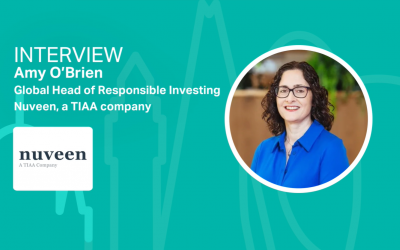Stuart Kinnersley from AIM talks impact investing
We interviewed Stuart Kinnersley, Managing Partner at Affirmative Investment Management and discussed impact investing and what's driving the increased interest

We interviewed Stuart Kinnersley, Managing Partner at Affirmative Investment Management and discussed impact investing and what's driving the increased interest.
How would you describe impact investing?
Impact investments are investments in companies, agencies or projects with the intention to generate specific, measurable and positive social and/or environmental outcomes, alongside a financial return. The growing impact investment market provides capital to address the world’s most pressing challenges.
At our firm, Affirmative Investment Management (AIM), we are solely dedicated to impact fixed income investing, along with impact measurement and reporting. Our approach to Impact investing is identifying financial instruments that provide market returns but have the additional objective and ambition of generating a positive environmental and/or social outcome over and above the financial return. Our focus is very much on debt instruments, which provide clarity and transparency as to where the money is going but, importantly, also have a commitment to report outcomes in a systematic way. This additional accountability and transparency provides us with the evidence we require to generate detailed portfolio-based impact reports.
What do you think is driving the increased interest in impact investing?
There are multiple forces and motivations at work, and it is also linked to mission alignment of institutions and client demand. We are seeing greater awareness and realisation that the financial system could be instrumental in addressing the pressing challenges facing the world. People are getting it. There is now a deeper understanding that all investments have an impact, and that in the past it turns out many of these impacts unfortunately have been negative. These negative externalities have not been considered for a long time. Additionally, climate change and carbon emissions issues remain the most critical issues of our time. People are seeking ways to address climate change risk and build resilient communities, and COP 21 and the UN Sustainable Development Goals has rallied them on this issue. Finally, we see increased interest in impact investing driven by millennials, many of whom have widespread interest in sustainability and are interested in investing with positive environmental and social impact.
What do you think is leading to the growth in impact investing?
Education, awareness, and the availability of new products (e.g. green bonds) are all leading to the growth in impact investing. There is also greater awareness and more evidence that financial returns do not need to be compromised if done properly. Portfolios that generate positive environmental and social impacts can be run without compromising financial returns.
What do you think are some of the biggest challenges and opportunities in impact investing?
I think one of the challenges is balancing the need to be pragmatic while maintaining standards. For example, how should we view issuers in a high carbon or polluting industry that are in transition and have an ambitious sustainability strategy? If we look at these types of issuers, there is a delicate balance between the need to maintain our integrity and standards while at the same time be aware that there those who disagree with that approach or are cynical.
One of the biggest opportunities in impact investing is the need to finance COP21 and support UN Sustainable Development Goals. There is a growing recognition that finance needs to become sustainable and we have an opportunity and powerful tool to make a difference.
Given your years of experience in the impact bond market, what is your opinion on the evolution and growth of the market?
I think that the market is set to continue to grow rapidly and broaden, deepen and become more mainstream. I am reluctant to predict exact figures, but it’s very easy to see this being a $1trn market in next 3 to 5 years.
What are AIM’s product offerings? What is available for investors in the US? What is the US$ Liquid Impact Fund?
We have an investable universe of bonds across different currencies, maturities and credit ratings which has allowed us to manage different strategies across the entire yield curve. We manage a multi-currency duration fund for Lombard Odier, the Global Climate Bond Fund, which was awarded ‘Green Bond Fund of the Year’ by Environmental Finance in March 2018. We have also recently announced a strategic Alliance Partnership with Colonial First State and the launch of the Affirmative Global Bond Fund in Australia on the platform. We run single currency Euro and US$ impact bond strategies as well.
I am delighted to announce that we have recently launched our Delaware based AIM US$ Liquid Impact Fund LLC (US$ LIF). Throughout the world, there are significant pools of concentrated cash held by corporates, governments and money market strategies -we estimate this might amount to trillions of US dollars. Much of this cash can be deemed ‘idle’. We designed this strategy almost 3 years ago as a scalable vehicle to bridge the gap between the aspiration and solution of low carbon sustainable growth. Our ambition is to funnel a considerable proportion of this “idle” cash into a positive source of finance that will support a speedy transition to low carbon growth and the building of resilient communities.
The US$ LIF invests primarily in marketable, short dated, US$ denominated, high grade debt securities and money market instruments, which have been identified by us as having a positive environmental and/or social impact. This fund only invests in high grade issuances that have been evaluated and approved by our in-house Verification team. In addition to the sustainability criteria, the evaluation process also focuses on engagement with issuers, transparency of reporting by the issuer and measurable impact of the underlying proceeds. We are issuing an updated detailed annual impact report for this strategy, which will include information about greenhouse gas avoidance, the geographic disbursement of proceeds and alignment to the UN Sustainable Development Goals.
We are very excited about our US$ LIF and have seen genuine interest in this Fund. All of our strategies are available to US clients through separately managed accounts (SMAs), but the US$ LIF is the only fund vehicle available at present. We look forward to sharing our experiences in impact investing with attendees at The Sustainable Investment Forum North America and Climate Week NYC.
Stuart will be speaking at the Sustainable Investment Forum in New York on the 26th September 2018, to find out more visit www.sinvforum.org






